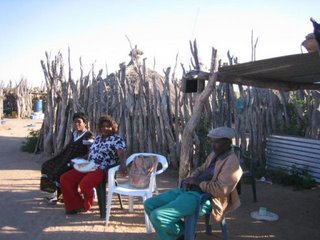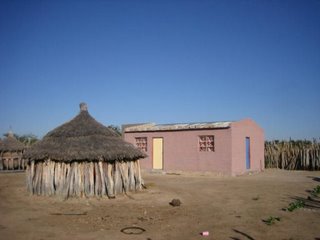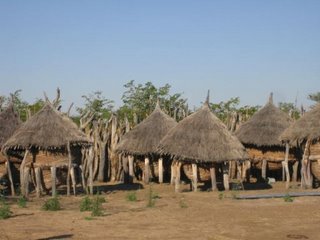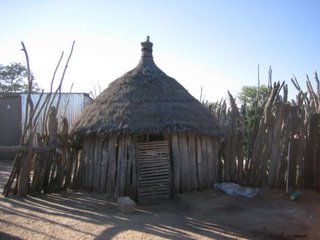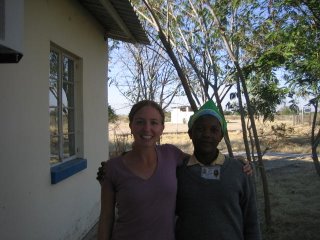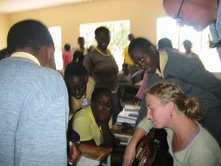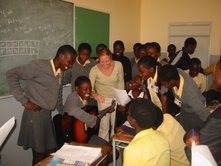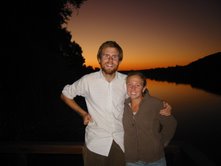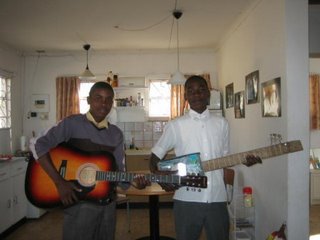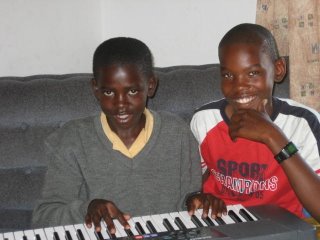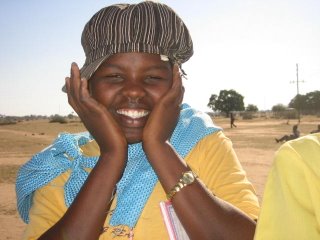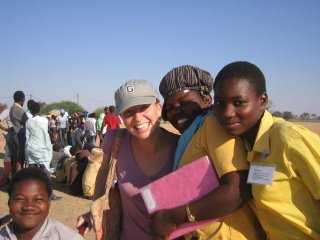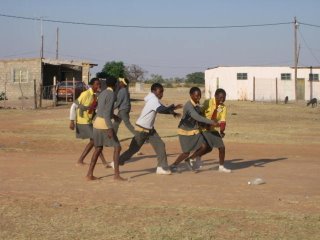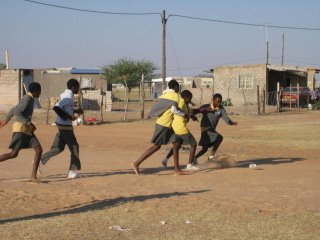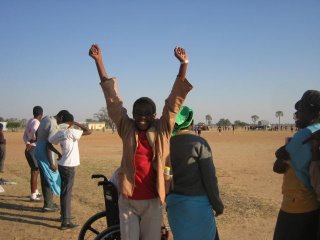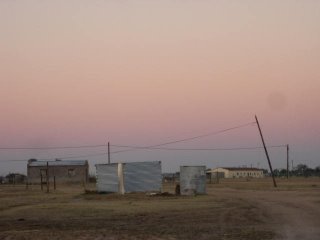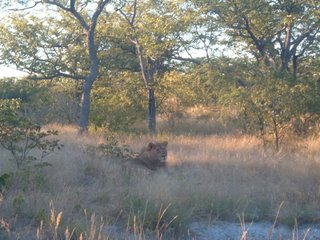Last week, the young child of a good friend passed away. I missed the funeral at the weekend because no one had enough credit on their mobile phones to call and tell me the news. My friend, who is a teacher at my school, is only a year older than me and her baby was only eight months old. Her beautiful baby was full of life such a short time ago; “she is very naughty” was how my friend liked to describe her with a laugh.
I was told the news by another colleague, Emily, who is very close to my friend, Irene. She was very upset telling me the news. I also regard Emily as a friend, and several months ago I learned that she is raising her three sons by herself because her husband was killed in a road accident four years ago. I thought about this as she told me about Irene’s baby.
Death is so common here. Approximately 25% of the adult population in Namibia has HIV/AIDS. This percentage is higher in regions such as Caprivi where it is at least 40%. These figures are based on pregnant women who are tested when they go to hospital to deliver. These women can choose to know their results or not. Fatal road accidents are also common. People travel in minibuses that are packed far beyond maximum capacity and it is not uncommon for the driver to be drunk. It is dangerous to drive at night because there are no road lights and lots of wandering animals.
Emily did not tell me what caused the child’s death. I asked another colleague, Wilhelmina, if it was diarrhea, and she thought that was likely, although she didn’t know for sure. Irene lives in town and has running water, yet it is possible that her child died from diarrhea. Or it is possible that the child had malaria. It also crossed my mind that her baby was HIV positive.
Another colleague was absent for several weeks at the end of last term to bring her baby to and from Windhoek for treatment for her eyes. This is an undertaking for most people here in the north as they do not own their own transport. It is at least a 12 hour journey from our town to Windhoek by minibus. I never knew what exactly was wrong with my colleague’s child. When I returned from the holidays in May, I asked my colleague how her baby was. She told me that the doctors had removed one of her daughter’s eyes.
One of my grade 11 students lost both her parents to AIDS five years ago. She and her brothers and sisters were sent to live with an aunt. They left their aunt’s house because she didn’t give them enough food to eat. They returned to their family home to live by themselves. My student was 12 years old at the time and her oldest sibling was 18 years old. A couple of years later her youngest sister died at the age of 8. I suspect that she was born HIV positive. A friend described the funeral for me. One part has stuck in my mind clearly. There was a can of air freshener on the small coffin and every so often a woman would spray around the coffin. White froth, where it had been sprayed too close, marked the coffin edges.
My student’s oldest sister now has a one year old child of her own. The baby went to the hospital last week because of diarrhea. My student said that the baby must have been witched. I imagine that many people’s responses to witchcraft vary from such emotions as disbelief, scorn and amusement. Yet, I think that there is some very logical and practical reasoning behind the belief in witchcraft, although I don’t think that this practical reasoning is necessarily cognizant thinking on the part of witchcraft believers. For example, I remember one of my professors telling me a story about a place in Africa (unfortunately I don’t remember where exactly) where people in rural communities kill old people during times of drought. This is ostensibly because the old people are thought to have somehow caused or prolonged the drought. In purely practical terms, however, the old people of the community consume precious resources in times of drought without adding to the productivity of the community. Survival of the fittest, I guess. Although not the stated reason for killing the old people in the community, it alleviates the community’s situation as a whole by lessening the number of people that must be fed during hardship. In terms of my student’s niece, her sister is very poor and perhaps her belief that her child is sick due to witchcraft reduces her accountability for the child’s health, thereby lessening the need to invest in additional money or food for the baby.
I went to Irene’s village to visit her with two colleagues on Tuesday afternoon. During the school day, I asked some colleagues what I should bring her. Money, I was told. I made a card and signed it on behalf of all three of us. We left school at 2 o’clock and I phoned Irene to make sure she would be home. When she answered, I hardly recognized her voice – she sounded so tired and sad. She said she would be home around 3 o’clock. With an hour to spare, my colleagues, Wilhelmina and Elizabeth, decided they would do some shopping. This first involved going to buy some food for Elizabeth, who is seven and a half months pregnant, and who was ravenous. She got some chicken. Side note: I rarely see my colleagues eating during the school day. If they do, it is only small amounts of traditional food that women from the nearby villages sell outside our school, such as fat cakes, which are fried balls of bread, traditional bread, pieces of chicken or whatever traditional snack is in season, e.g. mopane worms, groundnuts or “traditional sweets”, which are the small fruit from jackal-berry trees.
After Elizabeth got her chicken, we went to her house so that she could change into a traditional dress before we went to the village. Then Wilhelmina decided she wanted to go to another shop to pick up a few things. After that we stopped so that Elizabeth could buy some oranges on the side of the road. Then Wilhelmina thought that we should stop at a cuca shop (local bar) to buy some beer. Finally, after all that, we got on the road to Irene’s village. About 10km outside of Outapi we turned off the main road and came to some small cuca shops. Wilhelmina told me that this was where she lived. She knew everyone, and they all seemed to be related to her in some way or another. We stopped at “Mastermind”, a cuca shop so-called because its owner is known as Mastermind, who I was lucky enough to meet. There we drank our beers and talked about village news. A current hot topic in Namibia is the issue of licensed shebeens. Many of these bar owners do not own licenses and the police are now shutting them down. The owners are outraged. Anyway, Wilhelmina pointed out that the cuca shop we were drinking at no longer had any beer on their shelves – all they were selling were cool drinks (i.e. soft drinks). The bars on either side of “Mastermind” had been closed down just the day before.
At one point, after Wilhelmina had gotten up to speak to somebody, Elizabeth whispered furtively in my ear: “Her brother, that man you just shook hands with, he has AIDS.” I didn’t really know how to respond, and perhaps I looked a little puzzled, because she then said she was only telling me because she thought I had noticed the spots on his arms. She went on to say that last year he almost died, but then he started taking medicine and that now whenever she sees him he seems very happy. He looked great to me.
Eventually, an hour and a half since we first left school, Elizabeth and Wilhelmina decided that we should go to the village. We navigated the small paths of the village for quite a distance until we eventually reached the kraal belonging to Irene’s father. Her father told us that she wasn’t back yet, so we waited. At 4 o’clock we decided to leave. We gave the card, into which we had each put $50, to her father. As we were leaving the village, we met the car Irene was traveling in, which was filled with other women including two of her sisters and her mother. She got out and we all hugged her. Her cheeks were trembling as she spoke. She asked us if we heard how her baby had died. We said no. She said that her baby was poisoned. Then she said that only yesterday, all these stories had come out. The village girl who babysat her child in town for her while she was working during the day told her that someone had come to visit the child in her absence and had given the baby sweets. Irene believes that this person poisoned her baby. She kept saying, “I have no power to do anything.” She wants someone to take up her case. Afterwards, when we left, I didn’t know what to think. It is hard for me to believe that someone would poison her child. Irene believes the motive is jealousy. I can’t help wondering if the girl who babysat the child is just trying to exculpate herself. Yet, Irene does not question the story at all.
Irene’s oldest sister was also in the car and was with her own small child. Elizabeth went over to them and started playing with the baby. Irene watched them and couldn’t suppress a small smile at one point. Yet, all I could think was how bitter I would feel at that moment if I was in her shoes, watching my sister and her small child and my friend who is heavily pregnant playing together after I had just lost my own baby.
The next day another colleague, the woman whose baby girl lost her eye last month, asked how the visit went. I told her that Irene seemed very sad and thin. She said “Yes, but these things happen and you must be strong. You can’t take them back.” Once a person is buried, you are no longer supposed to cry in Owambo culture.

